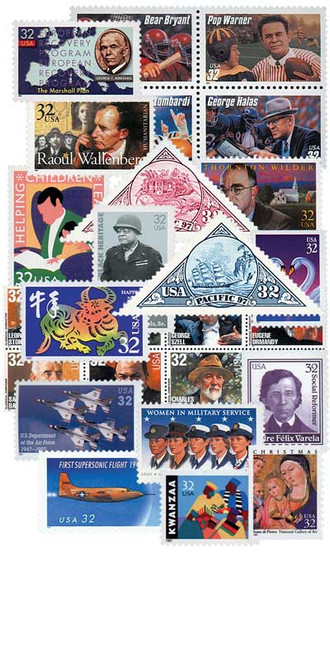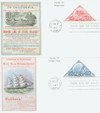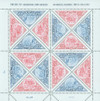
# 3130-31 - 1997 32c Stagecoach and Ship
US #3130-31
1997 Pacific ’97
- First US triangle stamps
- Publicized the Pacific ’97 international stamp show in San Francisco, California
Stamp Category: Commemorative
Set: ’Pacific 97
Value: 32¢, First Class Mail Rate
First Day of Issue: March 13, 1997
First Day City: New York, New York
Quantity Issued (if known): 130,000,000
Printed by: Banknote Corporation of America
Printing Method: Intaglio
Format: Triangular, Panes of 16 (4 blocks of 4)
Perforations: 11.2 by 11.3 (Wista stroke perforator)
Color: Blue (Ship) & Red (Stagecoach)
Tagging: Phosphored Paper
Why the stamp was issued: To publicize the Pacific ’97 international stamp show in San Francisco, California.
About the stamp designs: Pictures a ship and stagecoach, two of the main 19th-century forms of transportation associated with the San Francisco area. The vignettes are centered within ornamented frames reminiscent of classic engraved stamps.
Special design details: Designed by USPS art director Richard Sheaff with ornamental frames originally commissioned for the 1996 Olympic Games centennial stamps. They were designed by John Thompson of Hellman Associates in Iowa. Sheaff then added vignettes based on illustrated covers from the mid-1800s.
The engraving of the stagecoach is based on a drawing by Harrison Eastman (1823-1886), a post office clerk in San Francisco in 1849 until he became a painter, engraver, lithographer, and illustrator. Some small changes were made to the stagecoach image for use on this stamp.
The engraving of the clipper ship Richard S. Ely was based on a drawing from an advertising card promoting “Merchants’ Express Line of Clipper Ships for San Francisco” located on New York City’s East River. The background includes an artist’s depiction of Fort Point in San Francisco. This site was originally built by the US Army Corps of Engineers from 1853-1861 and is now a National Historic Site at the south end of the Golden Gate Bridge.
First Day City: First Day of Issue Ceremony at the Postage Stamp Mega-Event at the New York Coliseum in New York City. The event was standing room only, and all 800 ceremony programs ran out before every attendee received one.
History the stamp represents: Both the stagecoach and clipper ship were products of preindustrial times. With the dawning of the Industrial Revolution and steam power, their days were numbered. For a while, mail went by both stagecoach and railroad, by clipper ship and steamer. But before completely giving way to newer methods of transport, they proved the value of scheduled service, efficiency, and speed.
Ship
Clipper ships, the most beautiful and romantic of the sailing ships, appeared on the high seas in the 1850s, just as the preindustrial era was giving way to steam power. Maximizing the power of wind with narrow hulls and multiple tiers of sails, traders raced to be the first to market with China tea and Indian spices.
Clipper ships earned their place in postal history with the discovery of gold in California in 1848. At the time, miners, mail, and supplies had three routes to California. They could go by stagecoach through hostile land, by boat and coach across the unhealthy Isthmus of Panama, or by sailboat around Cape Horn. Speed was vital to survival and often meant the difference between striking it rich or losing everything. Ships like Sea Hawk, Flying Cloud, and Lightning “clipped off” the miles between New York and San Francisco in under three months, half the time needed for the overland journey.
Stagecoach
Stagecoaches played a vital role in postal history, providing the first scheduled mail service in modern times. In the early 1700s, England saw the dawning of the Industrial Revolution. And as economic activity increased, merchants clamored for a faster, more reliable mail system. To meet the demand, entrepreneurs initiated scheduled stagecoach services, while the government implemented a systematic road-building plan to develop a reliable transportation network.
Here in America, colonial postal service manager Benjamin Franklin followed England’s example and established scheduled mail service. By the mid-1700s, stagecoach and mail service linked the major cities of the East Coast. In 1840, the introduction of the world’s first postpaid, self-adhesive postage stamp – England’s Penny Black – further boosted economic activity.
Together, stagecoaches and postage stamps laid the foundation for a mail system that was fast, reliable, and efficient. Though stagecoaches were quickly replaced by railroads, they continued to provide vital services to inaccessible places into the 20th century.
US #3130-31
1997 Pacific ’97
- First US triangle stamps
- Publicized the Pacific ’97 international stamp show in San Francisco, California
Stamp Category: Commemorative
Set: ’Pacific 97
Value: 32¢, First Class Mail Rate
First Day of Issue: March 13, 1997
First Day City: New York, New York
Quantity Issued (if known): 130,000,000
Printed by: Banknote Corporation of America
Printing Method: Intaglio
Format: Triangular, Panes of 16 (4 blocks of 4)
Perforations: 11.2 by 11.3 (Wista stroke perforator)
Color: Blue (Ship) & Red (Stagecoach)
Tagging: Phosphored Paper
Why the stamp was issued: To publicize the Pacific ’97 international stamp show in San Francisco, California.
About the stamp designs: Pictures a ship and stagecoach, two of the main 19th-century forms of transportation associated with the San Francisco area. The vignettes are centered within ornamented frames reminiscent of classic engraved stamps.
Special design details: Designed by USPS art director Richard Sheaff with ornamental frames originally commissioned for the 1996 Olympic Games centennial stamps. They were designed by John Thompson of Hellman Associates in Iowa. Sheaff then added vignettes based on illustrated covers from the mid-1800s.
The engraving of the stagecoach is based on a drawing by Harrison Eastman (1823-1886), a post office clerk in San Francisco in 1849 until he became a painter, engraver, lithographer, and illustrator. Some small changes were made to the stagecoach image for use on this stamp.
The engraving of the clipper ship Richard S. Ely was based on a drawing from an advertising card promoting “Merchants’ Express Line of Clipper Ships for San Francisco” located on New York City’s East River. The background includes an artist’s depiction of Fort Point in San Francisco. This site was originally built by the US Army Corps of Engineers from 1853-1861 and is now a National Historic Site at the south end of the Golden Gate Bridge.
First Day City: First Day of Issue Ceremony at the Postage Stamp Mega-Event at the New York Coliseum in New York City. The event was standing room only, and all 800 ceremony programs ran out before every attendee received one.
History the stamp represents: Both the stagecoach and clipper ship were products of preindustrial times. With the dawning of the Industrial Revolution and steam power, their days were numbered. For a while, mail went by both stagecoach and railroad, by clipper ship and steamer. But before completely giving way to newer methods of transport, they proved the value of scheduled service, efficiency, and speed.
Ship
Clipper ships, the most beautiful and romantic of the sailing ships, appeared on the high seas in the 1850s, just as the preindustrial era was giving way to steam power. Maximizing the power of wind with narrow hulls and multiple tiers of sails, traders raced to be the first to market with China tea and Indian spices.
Clipper ships earned their place in postal history with the discovery of gold in California in 1848. At the time, miners, mail, and supplies had three routes to California. They could go by stagecoach through hostile land, by boat and coach across the unhealthy Isthmus of Panama, or by sailboat around Cape Horn. Speed was vital to survival and often meant the difference between striking it rich or losing everything. Ships like Sea Hawk, Flying Cloud, and Lightning “clipped off” the miles between New York and San Francisco in under three months, half the time needed for the overland journey.
Stagecoach
Stagecoaches played a vital role in postal history, providing the first scheduled mail service in modern times. In the early 1700s, England saw the dawning of the Industrial Revolution. And as economic activity increased, merchants clamored for a faster, more reliable mail system. To meet the demand, entrepreneurs initiated scheduled stagecoach services, while the government implemented a systematic road-building plan to develop a reliable transportation network.
Here in America, colonial postal service manager Benjamin Franklin followed England’s example and established scheduled mail service. By the mid-1700s, stagecoach and mail service linked the major cities of the East Coast. In 1840, the introduction of the world’s first postpaid, self-adhesive postage stamp – England’s Penny Black – further boosted economic activity.
Together, stagecoaches and postage stamps laid the foundation for a mail system that was fast, reliable, and efficient. Though stagecoaches were quickly replaced by railroads, they continued to provide vital services to inaccessible places into the 20th century.














